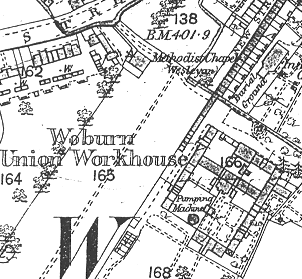Woburn, Bedfordshire
Up to 1834
Work began on the erection of a parish workhouse in Woburn in 1734. The building, now 19-20 Bedford Street, building was constructed by local bricklayer Thomas Edmonds with a donation of 1000 feet of timber from the Duke of Bedford. In 1762, the poor in the workhouse were "farmed" by Thomas Dean of Leighton Buzzard, for an annual fee of £140.
A parliamentary report of 1777 recorded parish workhouses in operation in Woburn (for up to 20 inmates), Chalgrave (10), Potsgrove (8), Tuddington [Toddington?] (28), and Wilden (2).
After 1834
The composition of the new Woburn Poor Law Union was the subject of intensive lobbying by one of the principal landowners in the area, Lord Charles Russell. Like many large landowners, Russell was keen for his estates to fall within a single union, so as to maximise his influence on the new Board of Guardians. The new union was officially formed on 10th April 1835. Its operation was overseen by an elected Board of Guardians,20 in number, representing its 16 constituent parishes as listed below (figures in brackets indicate numbers of Guardians if more than one):
Bedfordshire: Aspley Guise (2), Battlesden, Chalgrave, Eversholt, Harlington, Hockliffe, Holcutt, Husborn Crawley, Milton Bryant, Potsgrove, Ridgmont, Salford, Tilsworth, Tingrith, Toddington (2), Woburn (3). Later Additions: Aspley Heath (1883-99)
The population falling within the union at the 1831 census had been 10,633 with parishes ranging in size from Holcutt (population 49) to Toddington (1,926) — Woburn itself had a population of 1,827. The average annual poor-rate expenditure for the period 1831-34 had been £10,935 or £1.0s.7d. per head.
The new Board of Guardians had its first meeting on April 14th, 1835, and George Pearse was elected Chairman.
The new Woburn Union workhouse was built in 1835-6, for which the Poor Law Commissioners authorized an expenditure of £6,525. It was designed to accommodate 300 people and was built to the south of the village at the end of New Street. Its location can be seen on the map below.

Woburn site layout, early 1900s.
An 1899 plan (PRO MH14/37) indicates the layout of the site. The entrance range was at the north-east of the site and contained a porter's lodge and receiving wards, with the Guardians' board-room above. South of this, and running parallel to it, was an accommodation block for males (north-west wing) and females (south-east wing). Perpendicular wings at the ends of the accommodation block housed workshops or additional accommodation. At the centre of the site stood the master's house. By 1899, vagrants' wards had been added to the north-west. Out-buildings included a barn, stable, cart shed, four pigsties, and stone breaking sheds. There were also extensive kitchen gardens.
As a rationalisation of poor law operation in the area, the Woburn Poor Law Union was dissolved on the 29th September, 1899. The parishes of Chalgrave, Hockliffe and Tilsworth were transferred to Leighton Buzzard Poor Law Union, while the remainder joined Ampthill Union.
On 8th December 1899, the workhouse site and contents were put up for auction at the Bedford Arms Hote. The property was sold for £3,000 to the Duke of Bedford who owned most of the freeholds in the town. The workhouse buildings were demolished soon afterwards and some "model dwellings" erected on the site.
Staff
Inmates
Records
Note: many repositories impose a closure period of up to 100 years for records identifying individuals. Before travelling a long distance, always check that the records you want to consult will be available.
- Bedfordshire and Luton Archives and Records Service, Borough Hall, Cauldwell Street, Bedford. MK42 9AP. The limited holdings include: Guardians' minute books and ledgers (1835-1901 with gaps); School Attendance Committee minutes (1877-99); etc.
Bibliography
- Higginbotham, Peter The Workhouse Encyclopedia (2014, The History Press)
Links
Unless otherwise indicated, this page () is copyright Peter Higginbotham. Contents may not be reproduced without permission.


